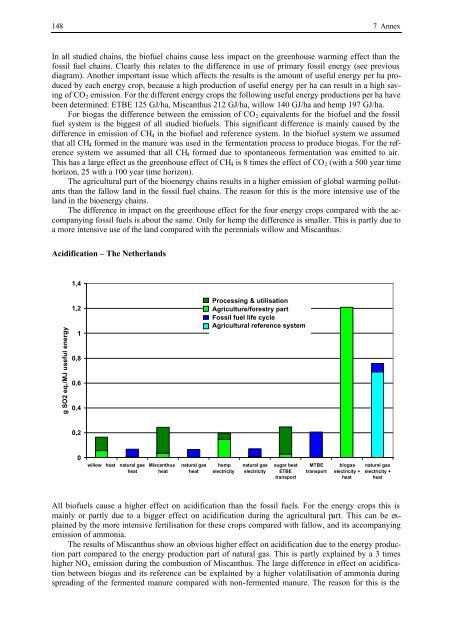BIOENERGY FOR EUROPE: WHICH ONES FIT BEST?
BIOENERGY FOR EUROPE: WHICH ONES FIT BEST?
BIOENERGY FOR EUROPE: WHICH ONES FIT BEST?
Create successful ePaper yourself
Turn your PDF publications into a flip-book with our unique Google optimized e-Paper software.
148 7 Annex<br />
In all studied chains, the biofuel chains cause less impact on the greenhouse warming effect than the<br />
fossil fuel chains. Clearly this relates to the difference in use of primary fossil energy (see previous<br />
diagram). Another important issue which affects the results is the amount of useful energy per ha produced<br />
by each energy crop, because a high production of useful energy per ha can result in a high saving<br />
of CO2 emission. For the different energy crops the following useful energy productions per ha have<br />
been determined: ETBE 125 GJ/ha, Miscanthus 212 GJ/ha, willow 140 GJ/ha and hemp 197 GJ/ha.<br />
For biogas the difference between the emission of CO2 equivalents for the biofuel and the fossil<br />
fuel system is the biggest of all studied biofuels. This significant difference is mainly caused by the<br />
difference in emission of CH4 in the biofuel and reference system. In the biofuel system we assumed<br />
that all CH4 formed in the manure was used in the fermentation process to produce biogas. For the reference<br />
system we assumed that all CH4 formed due to spontaneous fermentation was emitted to air.<br />
This has a large effect as the greenhouse effect of CH4 is 8 times the effect of CO2 (with a 500 year time<br />
horizon, 25 with a 100 year time horizon).<br />
The agricultural part of the bioenergy chains results in a higher emission of global warming pollutants<br />
than the fallow land in the fossil fuel chains. The reason for this is the more intensive use of the<br />
land in the bioenergy chains.<br />
The difference in impact on the greenhouse effect for the four energy crops compared with the accompanying<br />
fossil fuels is about the same. Only for hemp the difference is smaller. This is partly due to<br />
a more intensive use of the land compared with the perennials willow and Miscanthus.<br />
Acidification – The Netherlands<br />
g SO2 eq./MJ useful energy<br />
1,4<br />
1,2<br />
1<br />
0,8<br />
0,6<br />
0,4<br />
0,2<br />
0<br />
willow heat natural gas<br />
heat<br />
Miscanthus<br />
heat<br />
natural gas<br />
heat<br />
Processing & utilisation<br />
Agriculture/forestry part<br />
Fossil fuel life cycle<br />
Agricultural reference system<br />
hemp<br />
electricity<br />
natural gas<br />
electricity<br />
sugar beet<br />
ETBE<br />
transport<br />
MTBE<br />
transport<br />
biogas<br />
electricity +<br />
heat<br />
natural gas<br />
electricity +<br />
heat<br />
All biofuels cause a higher effect on acidification than the fossil fuels. For the energy crops this is<br />
mainly or partly due to a bigger effect on acidification during the agricultural part. This can be explained<br />
by the more intensive fertilisation for these crops compared with fallow, and its accompanying<br />
emission of ammonia.<br />
The results of Miscanthus show an obvious higher effect on acidification due to the energy production<br />
part compared to the energy production part of natural gas. This is partly explained by a 3 times<br />
higher NOx emission during the combustion of Miscanthus. The large difference in effect on acidification<br />
between biogas and its reference can be explained by a higher volatilisation of ammonia during<br />
spreading of the fermented manure compared with non-fermented manure. The reason for this is the

















